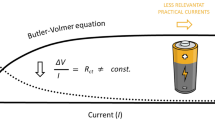Abstract
A hypothesis is suggested and grounded according to which a metal is passivated due to the formation of an oxide whose composition corresponds to the maximum oxygen concentration in the homogeneity area of this oxide on the metal surface. In this case, the thermodynamic probability of a corrosion process becomes close to zero. Experimental data are obtained on the dependence of the thermodynamic activity of carbon on its concentration in the homogeneity areas of cubic vanadium and titanium carbides. The dependences derived from these data are assumed to be also valid for metal oxides.
Similar content being viewed by others
References
N. D. Tomashov and G. P. Chernova, Passivity and Protection of Metals against Corrosion (Nauka, Moscow, 1965).
V. A. Kireev, Course of Physical Chemistry (Goskhimizdat, Moscow, 1956).
G. Davies and A. James, Dictionary of Electrochemistry (Macmillan Press, London, 1976).
N. N. Sirota, Physicochemical Nature of Variable Composition Phases (Nauka I Tekhnika, Minsk, 1970).
N. P. Zhuk, Theory of Corrosion and Protection of Metals (Metallurgiya, Moscow, 1976).
V. I. Alekseev and Yu. N. Surovoi, “Technique of Studying the Thermodynamic Properties of Alloys,” Zavod. Lab. XXXI(11), 1356–1358 (1965).
V. I. Alekseev and E. M. Parnis, “Radiometric Method for Determining the Thermodynamic Activity of Carbon in Steels and Alloys,” Zavod. Lab., No. 10, 1207–1208 (1972).
S. Aronson and J. Sadofsky, “Thermodynamic of Carbide VCx,” J. Inorgan. Nucl. Chem. 27, 1769–1773 (1965).
E. Fromm and E. Gebhard, Gase und Kohlenstoff in Metallen (Springer, Berlin, 1976).
N. D. Tomashov, Theory of Corrosion and Protection of Metals (MacMillan, New York, 1966).
K. Schwabe and W. D. Arnold, in Proceedings of 5th International Congress on Metallic Corrosion (NACE, Houston, 1974), p. 760.
R. Todoroki, S. Kado, and A. Teremae, in Proceedings of 5th International Congress on Metallic Corrosion (NACE, Houston, 1974), p. 764.
L. Onsager, “Reciprocal Relation in Irreversible Processes,” J. Phys. Rev. 37, 405 (1931).
J. Kruger, J. Electrochem. Soc. 110 (6) (1963).
H. Uhlig, D. Triadis, and M. S. Stern, J. Electrochem. Soc. 102(1), 59 (1955).
T. P. Hear and U.R. Evans, J. Electrochem. Soc. 99(5), 212 (1962).
M. Nagyama and M. Cohen, J. Electrochem. Soc. 109(9), 784 (1962).
Author information
Authors and Affiliations
Corresponding author
Additional information
Original Russian Text © V.I. Alekseev, V.S. Yusupov, M.M. Perkas, G.Yu. Lazarenko, 2012, published in Metally, 2012, No. 1, pp. 60–68.
Rights and permissions
About this article
Cite this article
Alekseev, V.I., Yusupov, V.S., Perkas, M.M. et al. On the nature of metal passivation during cathode depolarization by oxygen dissolved in an electrolyte. Russ. Metall. 2012, 48–54 (2012). https://doi.org/10.1134/S0036029512010028
Received:
Published:
Issue Date:
DOI: https://doi.org/10.1134/S0036029512010028




